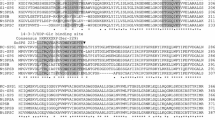Summary
Sporamin, which accounts for 80% of the total soluble proteins in sweet potato tuberous roots, consists of two polypeptide classes, A and B. The sporamin cDNA clones can also be classified into sporamin A and B subfamilies based on their sequence homologies, with intra-subfamily homologies being much higher than inter-subfamily homologies. The sequence of an essentially full-length cDNA for sporamin B was compared with that for sporamin A. The coding sequences of two cDNAs share 83% sequence homology. The sequences in the 5′- and 3′-noncoding regions show many deletions in addition to base substitutions. The endpoints of deletions longer than 4 bp match precisely to the endpoints of short direct repeats present in the other sequence, which suggests that these deletions are generated by slipped mispairing during DNA replication. In the 5′- and 3′-noncoding region of sporamin B cDNA, there are 5 bp direct repeats with sequences complementary to each other. Since most of these repeats are absent in sporamin A cDNA, these structural features may cause a difference in the secondary structure between A and B mRNAs and affect the translational efficiencies or stabilities of the mRNAs. Precursors for both classes of sporamin carry N-terminal extra-sequences which can be separated into a putative signal peptide segment and a segment enriched with basic amino acids. A two-step processing mechanism for the maturation of sporamin is suggested.
Similar content being viewed by others
References
Crouch ML, Tenbarge KM, Simon AE, Ferl R: cDNA clones for Brassica napus seed storage proteins: Evidence from nucleotide sequence analysis that both subunits of napin are cleaved from a precursor polypeptide. J Mol Appl Genet 2:273–283, 1983.
Efstratiadis A, Posakony JW, Maniatis T, Lawn RM, O'Connell C, Sprits RA, DeRiel JK, Forget BG, Weissman SM, Slightom JL, Blechl AE, Smithies O, Baralle FE, Shoulders CC, Proudfoot NJ: The structure and evolution of the human β-globin gene family. Cell 21:653–668, 1980.
Farabaugh PJ, Miller JH: Genetic studies of the lac repressor: VII. On the molecular nature of spontaneous hotspots in the lacI gene of Escherichia coli. J Mol Biol 126:847–863, 1978.
Graham JS, Pearce G, Merryweather J, Titani K, Ericsson L, Ryan CA: Wound-induced proteinase inhibitors from tomato leaves; 1. The cDNA-deduced primary structure of pre-inhibitor 1 and its post-translational processing. J Biol Chem 260:6555–6560, 1985.
Grunstein M, Hogness D: Colony hybridization: A method for the isolation of cloned DNAs that contain specific gene. Proc Natl Acad Sci USA: 72:3961–3965, 1975.
Hall TC, Slightom JL, Ersland DR, Murray MG, Hoffman LM, Adang MJ, Brown JWS, Ma Y, Matthews JA, Cramer JH, Barker RF, Sutton DW, Kemp JD: Phaseolin: Nucleotide sequence explains molecular weight and charge heterogeneity of a small multigene family and also assists vector construction for gene expression in alien tissue. In: Ciferri O, DureIII L (eds) Structure and Function of Plant Genomes. Plenum Press, New York, 1983, pp 123–142.
Hattori T, Nakagawa T, Maeshima M, Nakamura K, Asahi T: Molecular cloning and nucleotide sequence of cDNA for sporamin, the major soluble protein of sweet potato tuberous roots. Plant Mol Biol 5:313–320, 1985.
Hattori T, Sakajo S, Iwasaki Y, Asahi T: Cell-free synthesis of succinate dehydrogenase and mitochondrial adenosine triphosphatase of sweet potato. Biochem Biophys Res Commun 113:235–240, 1982.
Kasarda DD, Okita TW, Bernardin JE, Baecker PA, Nimmo CC, Lew EJ-L, Dietler MD, Greene FC: Nucleic acid (cDNA) and amino acid sequences of α-type gliadins from wheat (Triticum aestivum). Proc Natl Acad Sci USA 81:4712–4716, 1984.
Maeshima M, Sasaki T, Asahi T: Characterization of major proteins in sweet potato tuberous roots. Phytochemistry 24:1899–1902, 1985.
Maniatis T, Fritsch EF, Sambrook J: Molecular Cloning. Cold Spring Harbor Laboratory, Cold Spring Harbor, New York, 1982.
Messing J: New M13 vectors for cloning. Methods Enzymol 101:20–78, 1983.
Messing J, Geraghty D, Heidecker G, Hu N-T, Kridl J, Rubenstein I: Plant gene structure. In: Kosuge T, Meredith CP, Hollaender A (eds) Genetic Engineering of Plants. Plenum Press, New York, 1982, pp 211–227.
Mignery GA, Pikaard CS, Hannapel DJ, Park WD: Isolation and sequence analysis of cDNAs for the major potato tuber protein, patatin. Nucleic Acids Res 12:7987–8000, 1984.
Murray MG, Thompson WF: Rapid isolation of high molecular weight plant DNA. Nucl Acids Res 8:4321–4325, 1980.
Nakamura K, Hattori T, Asahi T: Direct immunological identification of full-length cDNA clones for plant protein without gene fusion to E. coli protein. FEBS Lett 198:16–20, 1986.
Nishiyama I: Evolution and domestication of the sweet potato. Bot Mag Tokyo 84:377–387, 1971.
Okayama H, Berg P: High-efficiency cloning of full-length cDNA. Mol Cell Biol 2:161–170, 1982.
Paiva E, Lister RM, Park WD: Induction and accumulation of major tuber proteins of potato in stems and petioles. Plant Physiol 71:161–168, 1983.
Perlman C, Halvorson HO: A putative signal peptidase recognition site and sequence in eukaryotic and prokaryotic signal peptides. J Mol Biol 167:391–409, 1983.
Rosahl S, Schmidt R, Schell J, Willmitzer L: Isolation and characterization of a gene from Solanum tuberosum encoding patatin, the major storage protein of potato tubers. Mol Gen Genet 203:214–220, 1986.
Salser H: Globin mRNA sequences: Analysis of base pairing and evolutionary implications. Cold Spring Harbor Symp Quant Biol 42:985–1002, 1977.
Schuler MA, Ladin BF, Pollaco JC, Freyer G, Beachy RN: Structural sequences are conserved in the genes coding for the α, α′ and β-subunits of soybean 7S storage protein. Nucl Acids Res 10:8245–8261, 1982.
Spena A, Krause E, Dobberstein B: Translation efficiency of zein mRNA is reduced by hybrid formation between the 5′- and 3′-untranslated region. EMBO J 4:2153–2158, 1985.
Zuker M, Stiegler P: Optimal computer folding of large RNA sequences using thermodynamics and auxiliary information. Nucl Acids Res 9:133–148, 1981.
Author information
Authors and Affiliations
Rights and permissions
About this article
Cite this article
Murakami, S., Hattori, T. & Nakamura, K. Structural differences in full-length cDNAs for two classes of sporamin, the major soluble protein of sweet potato tuberous roots. Plant Mol Biol 7, 343–355 (1986). https://doi.org/10.1007/BF00032564
Received:
Revised:
Accepted:
Issue Date:
DOI: https://doi.org/10.1007/BF00032564




